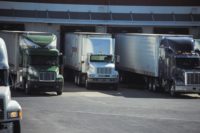From food and beverage to ingredient management, the “Uberization” trend is disrupting traditional business models, where shippers use smartphones and mobile apps to fully leverage otherwise-empty trucks while also dealing more directly with drivers (vs. just carriers and freight forwarders).
This level of Uberization should be a lifeline for food shippers feeling the impact of the capacity crunch and truck driver shortage. Exacerbated by regulations like the electronic logging device (ELD) mandate and a strong national economy, these challenges aren’t getting any easier for shippers that need to get their fresh and frozen products to the right place at the right time and for the right price.
The Uberization of freight leverages technology in real-time via an ecosystem of carriers that the shipper wouldn’t otherwise be aware of (or be able to connect with). Much like having a network of cars in the vicinity that are willing to give a stranger a ride in exchange for payment, shippers have an app that provides visibility to that ecosystem of carriers.
This, in turn, helps companies more efficiently manage their transportation needs. Here are four ways refrigerated and frozen food shippers can use the Uberization of freight to their advantage and combat the capacity crunch:
1) Connect with thousands of independent drivers that have empty truck space. Despite popular belief, individuals who own and operate their own trucking businesses comprise a large chunk of the U.S. trucking industry. According to the OOIDA Foundation, Grain Valley, Mo., these 350,000, registered owner-operators either lease to carriers or operate under their own authority, which makes reaching and connecting with them extremely difficult. What better way to find independent drivers than through a mobile app that connects directly with them and allows you to secure otherwise-unused capacity on their reefers?
2) Leverage technology to handle the settlement. Though it’s nice to have real-time visibility of the asset through these Uber-like apps, there is still the issue of managing the asset to ensure driver certification, that freight is picked up and delivered and settlement is processed. Leveraging technology that can connect to various settlement and driver compliance platforms and broker communities that utilize these visibility apps will provide the ability to manage these drivers and settlement. Ultimately, having food shippers’ transportation management system (TMS) connect directly to the asset (driver) through a platform that provides access to drivers that ensures drivers’ certification and compliance as well as manages the settlement through an uber-like payment configuration is the nirvana.
3) Get the capacity you need on a transactional basis. Large, asset-based carriers own their own equipment and work directly with shippers, but historically, they didn’t mess much with transactional business. That’s because the asset-based carriers are into dedicated truckloads. And, when looking specifically for a refrigerated unit, it gets even more difficult. With the Uberization of freight, however, companies can more readily connect with the drivers that have open capacity and refrigerated capabilities on back-hauls, making it a win-win for shippers and carriers.
4) Fully leverage available refrigerated fleets. In a transportation market that’s in dire need of trucking assets, the ability to look at enterprise companies that have their own fleets and then transform those fleets into revenue-generating assets for those owners is literally the golden goose.
Participating in a community that provides access to an ecosystem of carriers not only enables this level of load matching, but also streamlines the transaction and enables solid shipper-carrier relationships. Rather than hammering the phones, calling 50 different companies and hoping for the best, food shippers can leverage technology to gain real-time visibility over truck assets while knowing that the settlement, liability and other functions are being managed through a single interface. It’s basically a no-brainer in today’s challenging transportation market.



